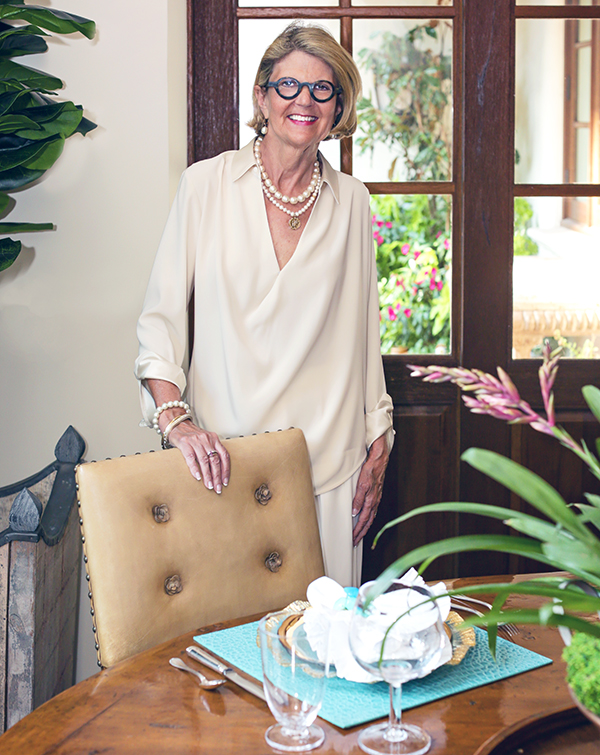Get Your Elbows Off My Column

As I write this, I am awaiting a shipment from Italy of eight summery-looking ceramic dinner plates ordered on a July trip to the Amalfi Coast. By the time they arrive, I fear they won’t be the most seasonal-looking thing for an autumn dinner gathering. Perhaps you are rolling your eyes, reader, at my attempt to casually drop that I have recently been on vacay in Italy. As long as I am humblebragging, I’ll add that after my week there, I spent a week in Portugal. A very fun and beautiful vacation.
But I digress. The reason I liked the yet-to-arrive dinner plates is because they are large enough to double as service plates, also known as chargers, the underplates that anchor a first course, and which are meant to be cleared away for the entrée course, never to return until the next dinner party. I learned that last bit rather late in my hostessing career from my friend Jim Blair, Kansas City’s own version of Lawrence Lefferts,* when we were helping serve a charity dinner party. I was abashed to think of all the dinners I’d hosted, ignorant of the charger rule. I write a column. I’m supposed to know these things. And if you’re reading this column, you probably want to know these things, or maybe you feel you could use a refresher, or affirmation that you’re doing things properly. Here then, are a few points about table manners.
*In Edith Wharton’s The Age of Innocence, Lawrence Lefferts is considered the utmost authority on “form” in New York Society.
Relax, Have Fun and Mangia, Mangia!
Sharing a meal is one of life’s greatest pleasures. Both as guests and hosts, most of us are enjoying ourselves too much to scrutinize other people’s table manners, unless they do something egregious, like summon an Uber and leave in the middle of the main course (yes, that really happened at one of my dinner parties). In fact, I can forgive a guest almost anything if they are adding bounce to the conversation. Still, it feels good to have confidence that one is choosing the right fork.
Utensils: Work from the Outside In
The placement of utensils is based on simple logic dictated by the order in which they will be used. Forks are placed on the left of the plate: the one farthest from the plate is for the course you eat first. The same applies to knives. Etiquette books will tell you knives should be placed with cutting sides closest to the plate, one for each course, on the right of the plate, with the one to be used first farthest from the plate.
I will tell you I seldom have a dinner party so fancy it requires the use of two knives. I have exactly 12 place settings of my Joan of Arc sterling pattern, which means I have 12 dinner knives. But please know, darling, you don’t need silver flatware—or chargers!—to have a wonderful dinner party. Your everyday flatware is fine, and it doesn’t even need to match. Use your best stuff joyfully, no matter how humble it is. People are thrilled to be invited to your house for a meal. Always, always remember that.
No Soup for You!
When soup is the first course, the soup spoon is placed to the right of the knife or knives. Opinions vary on where the soup spoon goes when a soup or stew is the main course. If I’m serving Terry Anderson’s divine White Chili (email me for the recipe), I put the soup spoon in the same spot I would the dinner fork. But you could, when setting your table for a soup-centered dinner, plop those spoons down to the right of the knife and be perfectly correct.
When, as a diner, you are finished with your soup, put your spoon on the underplate, or anywhere it won’t flip over when being cleared. By the way, all dishes are supposed to be served from the left and cleared from the right, but sometimes we’re talking and clearing, and we forget and who cares, anyway? We’re not professional servers.
Fork Off, Dude
Any silverware directly above the plate is for dessert. I always leave dessert utensils off the table until I serve the final course, because to have that dessert flatware staring at me feels like I’m at a fundraiser in a hotel ballroom. But that’s just me.
If you’re setting your table for a dinner party, leave off any flatware that won’t be used for the meal, even though it may be part of a proper place setting. Extra flatware clutters the table and confuses guests.
Let’s Be Clear About Glassware
At a minimum, crystal at a dinner party should include glasses for wine and water. Stemmed wine glasses look prettiest on a table, but I have been at casual dinner parties where stemless wine glasses were used for both water and wine, and no one cared. Stemmed wine glasses have a tapered bowl while water goblets are rounder and flatter where the stem meets the bowl.
No order-of-usage maxims prevail with stemware. Set the taller glasses toward the center of the table, and the water glasses just above the knife on the right.
When You’re Puttin’ on the Dog
For a formal dinner, put out separate wine glasses for each different wine you plan to serve during the meal except for dessert wine or liqueur, such as a limoncello; these make their appearance along with the dessert service. If you plan to serve Champagne as your dessert wine, place Champagne glasses on the table from the beginning. Glasses don’t all need to be of the same pattern; it’s fine to mix. Many dinners I go to are casual enough that people just bring to the table the wine glasses from which they were drinking during cocktails.
You want your glasses to be impeccably spotless, for both aesthetic and hygienic reasons. Our dishwasher machines can’t be trusted to remove spots. Use a lint-free cotton or linen cloth to wipe each glass. Then set it by its stem on the table.
A Few Points of Guest Etiquette
Leave your phone off the table unless you have a babysitter at home or other extenuating circumstances.
If you find you need to remove food from your mouth during the meal, it should be taken away the same way it entered. Did you take the bite using a spoon? Extract the food using that spoon. The same goes if you use a fork or your fingers.
Please resist the temptation to discuss politics, religion, sex, money, or anything in excruciating detail.
Sundry Bits of Advice for Hosts
Ring a pleasant-sounding little bell to signal your guests that the cocktail hour is over and it’s time to move to the table. This feels so much more genteel than using your voice to interrupt their conversation.
Drinks should be served in glasses only half full—not out of stinginess, but because people gesticulate when talking and the drinks slosh over.
Remember to keep the centerpiece well below eye level so guests can see each other.
It’s not stuffy to use place cards; guests really appreciate knowing where you want them to sit after you’ve gone to all the work of hosting. Have fun with your place cards. Use endearments or nicknames to make your guests feel loved. Sit people boy girl boy girl, not next to their spouses.
Always use cloth napkins for a dinner party. Paper cocktail napkins are fine any time, although linen cocktail napkins add an extra bit of swank.
Set out pretty little bottles of Pellegrino or Perrier water for guests to take for the ride home. People are thankful for the extra hydration and it’s a hospitable way to signal the party is winding down.
The Elbow Question
For all we hear about “elbows off the table,” there are some situations where elbows are not only permitted on the table but actually necessary. This is true in noisy restaurants or clubs, where the only way to hear above the music and chatter is to lean far forward. Just as a point of vanity, we all look far more graceful leaning forward supported by our elbows than doubled forward over hands in our lap. At a home dinner party, elbows may be on the table because we have to lean forward in order to talk to a companion at a distance across the table. The best conversations often happen when we are lingering over a completed meal, and it’s perfectly fine to do so with your elbows on the table. But never put your elbows on the table when you are eating.
Email me with your entertaining questions, dilemmas, or triumphs at mjackson@inkansascity.com



